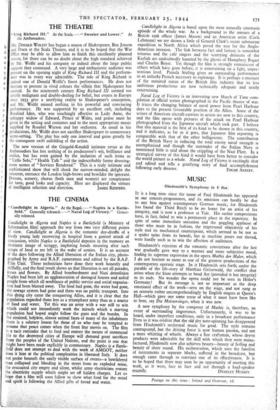THE CINEMA
field." Generally released.—" Naval Log of Victory." Gener- ally released.
Candlelight in Algeria and Naples is a Battlefield (a Ministry of Information film) approach the war from two very different points of view. Candlelight in Algeria is the romantic day-drealn of a lovely young lady recovering in hospital from a genteel attack of concussion, whilst Naples is a Battlefield deposits in the memory an obstinate image of scraggy, imploring hands straining after such scraps of food as are left in the wake of armies. It is an account of the days following the Allied liberation of the Italian city, photo- graphed by Army and R.A.F. cameramen and edited by the R.A.F. Film Unit. These technicians have done their work honestly and skilfully, and the final result shows us that liberation is not all parades, kisses and flowers. By Allied bombardment and Nazi demolition Naples had been left an agglomeration of damaged houses and unfed people from which all semblance of public service and social organisa- tion had been blasted away. The food had gone, the water had gone, the sewage system had gone and there was no public transport. Into this dying city came the conquering Allies, and it is clear that the population regarded them less as a triumphant army than as a source of food and water. Yet this was an army with a war still to win which could not immediately work the miracle which a starving population had hoped might follow the guns and the bombs. In the strained, helpless, almost animal faces of many of the inhabitants there is a salutary lesson for those of us who may be tempted to assume that peace comes when the front line moves on. The film is a tacit reminder that to feed and restore the means of communal life to the destroyed cities of Europe will demand great sacrifices from the peoples of the United Nations, and the point is one that might have been made explicitly in commentary. Naples is a Battle- field does not attempt to deal with the work of AMGOT, neither does it hint at the political complexities in liberated Italy. It does not probe beneath the easily visible surface of events—a bewildered man collapsed and bleeding in the street from an exploded mine, the evacuated city empty and silent, whilst army electricians restore the electricity supply which might set off hidden charges. Let us hope that a film will soon follow to show what food for the mind and spirit is following the Allied gifts of bread and water. Candlelight in Algeria is based upon the most naturally cinematic episode of the whole war. As a background to the amours of a British tank officer (James Mason) and an American artist (Carla Lehmann) we are shown a little of General Clark's secret submarine expedition to North Africa which paved the way for the Anglo- American invasion. The link between fact and fantasy is somewhat tenuous and the café singers and the scurrying denizens of the Kasbah are undoubtedly haunted by the ghosts of Humphrey Bogart and Charles Boyer. Yet though the film is strongly reminiscent of others which have gone before, it is entertaining on a light, unpre- tentious level. Pamela Stirling gives an outstanding performance as an unlucky French accessory to espionage. It is perhaps a measure of the matured status of the British film industry that its less ambitious productions are now technically adequate and neatly entertaining.
Naval Log of Victory is an interesting new March of Time com- pilation of official scenes photographed in the Pacific theatre of war. It traces the changing balance of naval power from Pearl Harbour days to the present favourable position of the Allies. Some of the scenes of American aircraft-carriers in action are new to this country, and the film opens with pictures of the attack on Pearl Harbour photographed from the Japanese aircraft which took part. I believe that this material is the first of its. kind to he shown in this country, and it indicates, as far as it goes, that Japanese film reporting is comparable with that of the other belligerents. The contribution of the British Navy in reducing the total enemy naval strength is unemphasised and though the surrender of the Italian Navy is mentioned little is said about the crippling of the Nazi Fleet. In a strategical survey of this kind it would have been better to consider the world picture as a whole. Naval Log of Victory is excitingly shot and edited and tells a gratifying story of final accomplishment


























 Previous page
Previous page